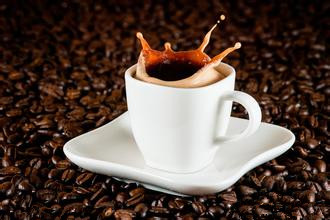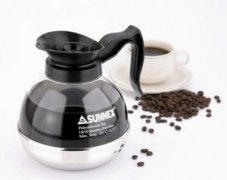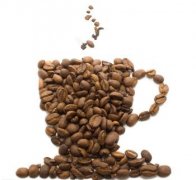Detailed process of hand-brewing coffee basic knowledge of coffee
Some people say that hand-brewed coffee is lazy coffee, but I think people who drink hand-brewed coffee must be process-oriented. The coffee dripping out through the filter paper is like filtering the taste of life in the hourglass of time. This experience adds a sense of ritual to hand-brewed coffee. A good cup of hand-made coffee teaches us about "slow refinement".

Hand-brewed coffee, you can literally understand its meaning: hand-brewed coffee. This brewing method was first invented by Ms. Melita in Germany at the beginning of the 20th century. At that time, when she was making coffee at home, she suddenly used her son's blotting paper as filter paper, put coffee powder in the filter paper, injected water into the coffee powder in a kettle, and extracted a cup of coffee with a different taste. Then she set up a company that makes hand coffee utensils that are popular. However, due to the invention of the coffee machine, this brewing method has not caused a large-scale popularity in the West.

(Mrs. Melita's brand)

(a single-hole filter cup invented by Mrs. Melita)
The fact that slow workers can make fine hand-made coffee is really popular, but it is caused by the Japanese. Since the 1950s, Japanese opponents have almost become obsessed with brewing coffee. Various kinds of filter cup appliances of various materials have emerged one after another, and a whole set of theory and operation technology of hand-brewed coffee have been established. It also makes the traditional way of hand-brewed coffee take root and bloom in the oriental land, and get unprecedented prosperity.
About equipment:
The equipment needed to make a cup of hand-made coffee is extremely simple:

Hand punch pot
For hand punching pots, it is best to choose thin-nosed pots to facilitate the control of water flow and direction. You can choose Japanese brands with relatively high prices, such as KALITA, HARIO, Taguchi and Moon Rabbit, or you can choose relatively cheap domestic brands such as TIAMO, Zhengzheng and so on.

Filter cup
Filter cup, filter cup material has ceramic, glass, copper, resin and so on, can be chosen according to personal preference, filter cup has single hole, double control, three holes, porous, but also to prevent blockage of the large hole cup, generally speaking, the more holes of the filter cup, the higher the flushing skills required, so beginners had better start from single hole and three holes.
At present, the most popular hand coffee filter cup is the V60 conical coffee filter cup made by HARIO Company. Its spiral groove can discharge the heat more effectively, and the deeper cone makes the coffee powder pile higher, so that the coffee can be steamed evenly, and the larger filter hole makes the effluent unimpeded.
You can also choose the American follicle pot, which was invented by German-born Dr. Peter J.Schlumbohm in the United States in 1941. Its design and particularity are recognized, not only selected as the "Illinois Institute of Technology" top 100 modern products, but also displayed by New York MoMa as a permanent collection of "Smithsonian and the Philadelphia Museum of Art".

American type follicle kettle
The uniqueness of the American bubble pot is that the coffee pot is integrated with the filter cup. The upper part of the filter cup of the American bubble pot has an air channel (air channel) in the shape of a funnel, which can supply air smoothly when extracting coffee, and the filter paper can be easily removed after use. The coffee extracted by the American filter pot can not only remove the excess oil and bitter ingredients, but also extract only the purest coffee. After frozen preservation, it still has its flavor even if it is heated and drunk again.

Filter paper
Filter paper, filter paper can absorb some of the miscellaneous smell of coffee, but also absorb a lot of coffee oil, so the brewed coffee has bright color and refreshing taste. The filter paper can be discarded immediately after being used once, which is more sanitary and easy to clean up. Almost all of the coffee brands mentioned above have filter paper. If you advocate environmental protection, you can also choose flannel filter.

Metal strainer
Some people prefer to use metal filter screen, because it saves the trouble of using filter paper every time, and also saves the cost of buying filter paper, but no matter how fine the filter screen is, there will always be a small amount of fine powder dripping down with the coffee liquid, and it is not very convenient to clean. However, the coffee brewed out of the metal filter retains the coffee oil, so it can be as close as possible to the original taste of the coffee, so the taste is relatively rich and mellow compared with the filter paper, which is very important for some people who pursue the original taste of coffee. It's very important to keep the oil.

Bean grinder
Bean grinder, it is recommended that friends who like to drink freshly ground coffee buy a reliable bean grinder, whether electric or manual, the quality of the product is much better than that of buying coffee powder, and the price of household use is not very high.
In addition to the above equipment, you also need a coffee cup (if many people enjoy it, you can choose to share the cup), thermometer (for measuring water temperature, the importance of making coffee by hand is self-evident. Of course, today's kettles all have the function of detecting water temperature), electronic scales (there is a certain proportion of how much coffee is extracted and how much coffee powder is needed), and a timer (data the temperature of the extraction).
As the most important feature of hand-brewed coffee is to retain the original taste of coffee, since it has been taken to make a cup of hand-brewed coffee, when choosing coffee beans, we must choose more high-grade coffee beans.
When the equipment and materials are ready, you can begin to prepare for hand punching.
Steps for making coffee by hand
Strictly speaking, how high the water temperature is for hand-brewed coffee depends on the characteristics of the beans. Generally speaking, the water temperature is 90 degrees Celsius.

Wet with water
Before brewing coffee, put the folded filter paper into the filter cup and put the filter cup on the coffee cup. Pour hot water into the filter cup, let the water wet the filter paper, remove the smell of the filter paper, and wet the filter cup and the coffee cup to warm up.

Ground beans
Pour out the hot water that you just poured into the cup. You can start grinding coffee beans. Generally speaking, 300ml coffee needs about 20g of coffee beans.

Add powder
Pour the ground coffee powder into a filter cup covered with filter paper.

Stuffy steam
It's steaming. Add water evenly and gently to the pot by hand to submerge the coffee powder. This step is called steaming and lasts about 20-25 seconds. At this time, you will see the coffee powder bubbling, which is the coffee particles releasing carbon dioxide, and the gap between the bubbles will make the coffee powder form a uniform filter layer to provide the space needed for hot water to pass through. The quality of steaming affects the formation of filter layer and directly affects the quality of extraction. Stuffy steaming is not good, the coffee taste will not be clean, mainly sour, coffee itself is difficult to reflect, the taste is thin, with irritation, the aroma is not dignified enough.

First water injection
After steaming, the center of the coffee powder is taken as the center, and the water is injected for the first time by drawing a circle with a larger flow of water, and the water is higher than the coffee powder. Remember that the water flow should not touch the filter paper directly and keep the circle within 1 cm from the edge of the coffee powder. The height of the current is maintained at about 4cm with the coffee powder on the surface of 3Murray. The amount of water injected for the first time accounts for 60% of the total amount of coffee.
The most important thing in hand flushing is the control of water flow, and the speed and intensity of water injection are very important. This is the technical point of this technique. The purpose is to let the coffee powder fully soak in the water, the water is higher than the coffee powder so that when the water is replenished, the water can flow evenly through the coffee powder. The finer the flow, the more sufficient the extraction.

Second water injection
Pause after the first water injection, wait for the water in the coffee powder to flow down completely, start the second water injection, the method is the same as the first water injection, the amount of water injection accounts for 30%.
Pause after the second water injection, wait for the water in the coffee powder to flow down completely, start the third water injection, the method is the same as the first water injection, the amount of water injection accounts for 10%.
When you reach the amount of coffee liquid extract, remove the filter cup immediately, regardless of whether the coffee liquid can still be dripped in the filter cup.

Pay attention to the current
Generally speaking, the thicker the water flow, the faster the rotational speed, the extracted coffee taste tends to be light and gentle, which is suitable for shallow baked beans; the finer the water flow is, the slower the rotational speed is, the more abundant the extraction is, and the coffee flavor is relatively strong. But the water flow thickness and rotational speed should be controlled properly, the water flow that is too thick and too fast is easy to underextract, and the coffee is light and tasteless or only shows a single bitter taste; the water flow that is too fine and too slow is easy to cause excessive extraction, and the coffee taste is dull and bitter.

Hand-made coffee
This is also the charm of hand-brewed coffee, which seems simple but full of all kinds of uncertainty. However, although there are many requirements for water temperature, time and brewing techniques, the whole process is nothing more than a pair of hands, a pot and a funnel.
The coffee brewed by everyone tastes different, and even the coffee brewed by the same person is not exactly the same. And that's the pleasure of making coffee by hand. Some people raise the process of "hand flushing" to the artistic conception of "heart brewing", saying that only such coffee has soul and vitality, who can say that it is not?
Important Notice :
前街咖啡 FrontStreet Coffee has moved to new addredd:
FrontStreet Coffee Address: 315,Donghua East Road,GuangZhou
Tel:020 38364473
- Prev

How to make coffee with alcohol
Maybe you prefer an American-style coffee maker, maybe you prefer a corkscrew, maybe you have a soft spot for mocha pots, or you have a particular preference for coffee frosts. The appliance is the medium to enjoy the brewing process. You can choose. How to cook a coffee with a good taste requires a certain amount of coffee knowledge. Let's take a look at what we need to pay attention to. A cup of coffee, mostly.
- Next

Basic knowledge of boutique coffee the preparation method of cappuccino coffee
Cappuccino at the beginning of the 20th century, Italian Achigasha invented the steam pressure coffee machine at the same time, also developed the cappuccino coffee. Cappuccino is poured with steamed milk on a strong coffee, the color of the coffee is like the dark brown robe worn by St. Franciscan monks, and the sharp foam on top of the coffee is like the small point on the monk's head.
Related
- Beginners will see the "Coffee pull flower" guide!
- What is the difference between ice blog purified milk and ordinary milk coffee?
- Why is the Philippines the largest producer of crops in Liberia?
- For coffee extraction, should the fine powder be retained?
- How does extracted espresso fill pressed powder? How much strength does it take to press the powder?
- How to make jasmine cold extract coffee? Is the jasmine + latte good?
- Will this little toy really make the coffee taste better? How does Lily Drip affect coffee extraction?
- Will the action of slapping the filter cup also affect coffee extraction?
- What's the difference between powder-to-water ratio and powder-to-liquid ratio?
- What is the Ethiopian local species? What does it have to do with Heirloom native species?

